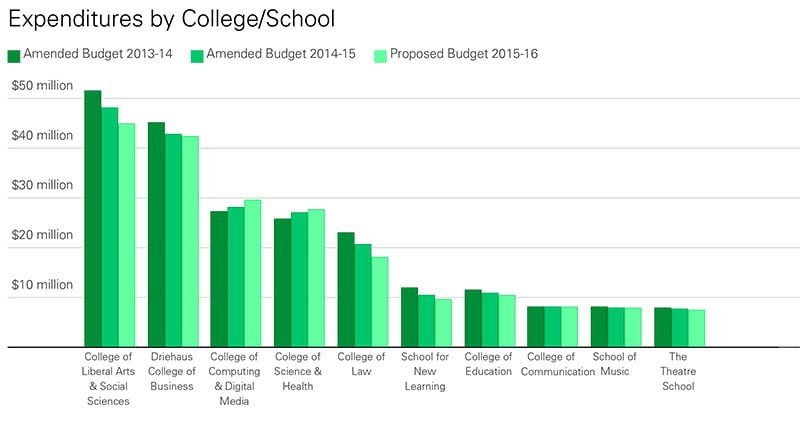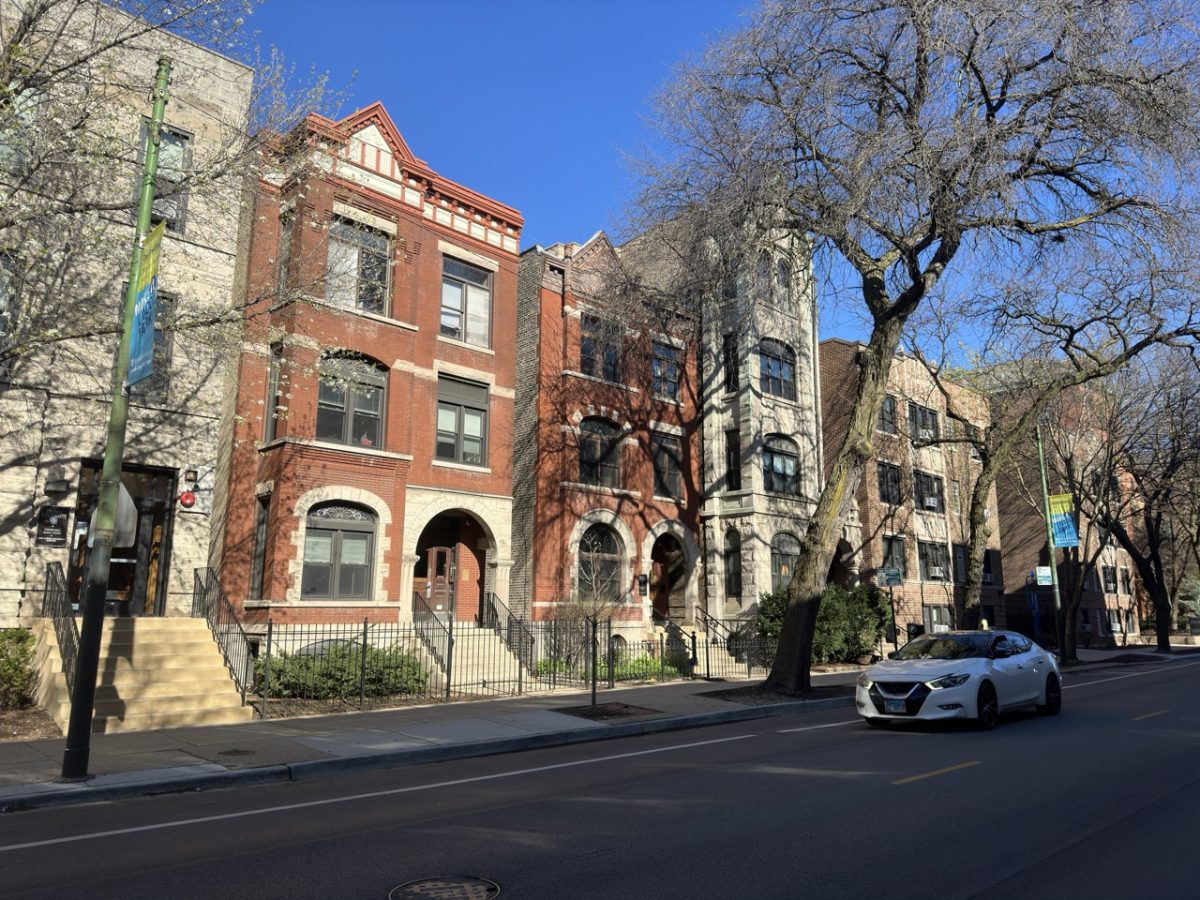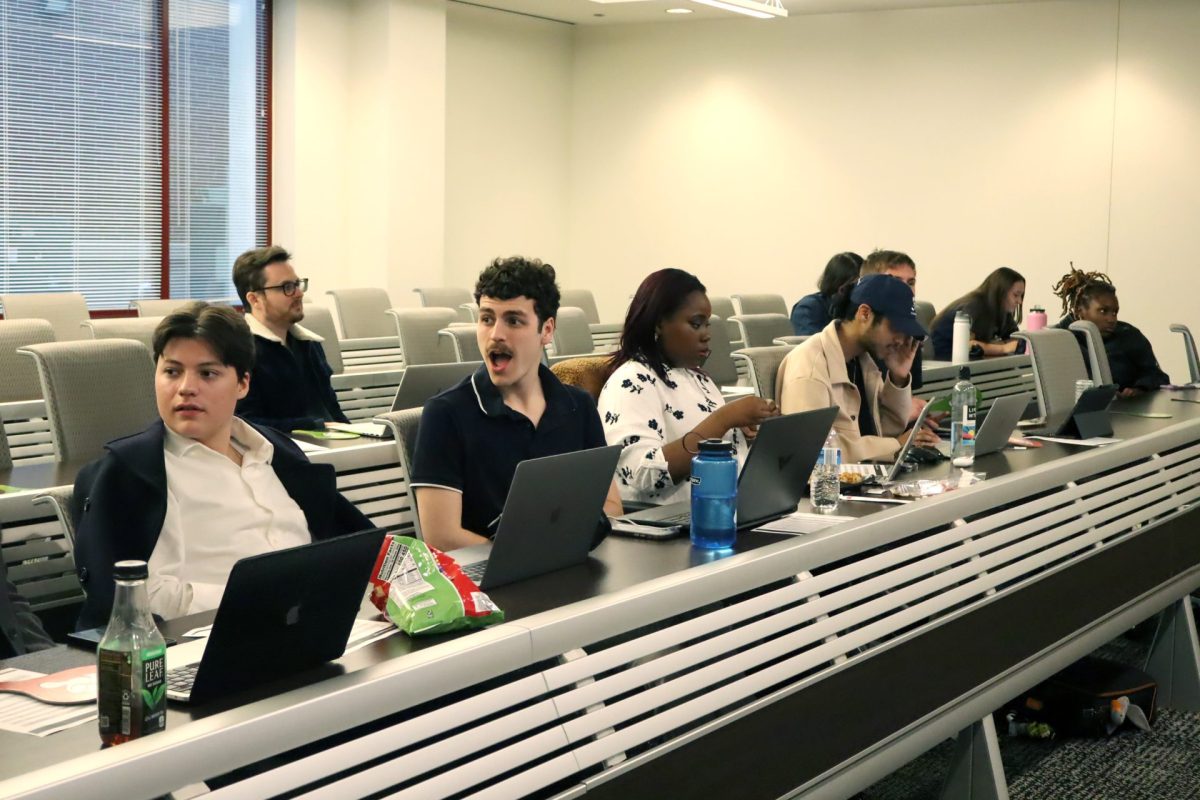
Amid a challenging enrollment environment nationwide, university leaders at DePaul were tasked with creating a budget that was realistic with the numbers, but one that upheld the university’s Vincentian values.
The budget was passed by the board of trustees in March after several months of work on it in various committees, where issues such as tuition pricing and employee compensation were prominently featured.
The results included a modest increase in tuition, 3.8 percent for incoming students, 2.5 percent for current undergraduates, and between 1 and 2 percent for graduate and law students, as well as cuts to many academic and operating units.
“I think we did the best we could,” economics professor Tom Mondschean, who serves as one of the Faculty Council representatives on the Strategic Resource Allocation Committee (SRAC), said. “We did not have as many resources as I would have hoped. The enrollment environment is stabilizing, but it’s not going up and so we really don’t have as much to work with as we’d like.”
Revenue is forecasted at about $547.2 million for the upcoming fiscal year, about a 2.8 percent decline from 2014.
Unlike public universities that receive funding from the state and private universities with large endowments, DePaul receives the vast majority of its revenue from tuition dollars.
This can be positive as it somewhat shields the university from the state’s fiscal crisis, but the downside is that even small fluctuations in enrollment can have a significant impact on the budget.
“Better than 80 percent of our revenue comes from tuition and the remainder is primarily from investment income, gifts and grants,” Executive Vice President Bob Kozoman said. “And if you compared us to an Ivy League, their tuition may be as little as 50 or 60 percent of their revenue.”
The difference is endowment, which Kozoman said can provide a buffer “against changes in enrollment” at certain universities.
DePaul’s endowment was more than $443 million, according to the most recent data. While many may see that number and question why the university does not use more of it, it is actually relatively small compared with universities of similar size.
“We have a relatively small endowment,” Kozoman said. “We didn’t start building it really until the early ‘80s. Although we are decent when it comes to fundraising, it’s still not a huge proportion of our budget, and our grant activity is pretty small, it’s maybe $15 million a year.”
The university currently pulls about 2 percent of it’s endowment for the budget every year, smaller than many universities where that percentage is closer to four or five.
“Some of us might like it at a higher percentage draw. But it’s not an unreasonable position to say that the endowment is there when you really, really need it and if we had a drop of 10 or 20 percent in revenue, to prevent massive layoffs, that we tap into it,” Mondschean said. “But we’re not there yet. So the trustees are saying don’t use it for this purpose, but save it for when there’s a really rainy day. It may be drizzling right now, but it’s not pouring.”
Restricted by these factors, the university budgets conservatively and conservatively forecasts revenue.
“We want numbers we can beat,” Kozoman said.
In order to meet expectations, work is done on the budget year-round. Starting in the summer and into early fall quarter, hypothetical budgets are constructed in academic and operating units and reviewed by those in managing roles.
Then around September and October, a tuition pricing committee studies trends and data, and then issues recommended tuition rates. Once this work is completed, the Strategic Resource Allocation Committee (SRAC) meets to discuss various budget issues and will vote to recommend a budget to the president. The president is then charged with presenting the budget to the board of trustees, who will vote on it typically in March.
Despite money being tight, it was decided early on that faculty and staff would get a 2.5 percent raise after more than two years of pay freezes.
“I think that there was a general consensus on SRAC that even if we have to cut a little more at the college level, the employees needed pay raises,” Mondschean said.
As the DePaulia reported during coverage of the provost search, morale was described by some faculty and staff as extremely low. Among their many grievances was the lack of a raise.
In addition, the university will begin to gradually increase its contribution to employee’s 403b plans from 8 percent to 10 percent. This budget will see the contribution increase by .5 percent.
“It turns out that the going rate at universities across the country is 10 percent,” Mondschean said. “We’ve been under matching for years and so it was decided that this year would be the year that we begin to restore equity on that issue.”
While these measure will add to the university’s personnel costs, it is partially offset by the many retirements of faculty and staff over the past few years. Many of those positions have remained unfilled.
The proportion of cuts was distributed fairly evenly in the three executive areas (departments reporting to the president, departments reporting to the executive vice president, and departments reporting to the provost), but the largest area, academic affairs, saw the highest amount of cuts.
Between 2014 and 2016, only the College of Computing and Digital Media and College of Science and Health have seen their funding increase. The law school, the School of New Learning and College of Liberal Arts and Sciences have all seen double-digit cuts.
According to interim provost David Miller, a lot of this has to do with enrollment numbers, but also ability to give back.
“Looking at multiple years at both the revenue and expense side of all those units, the fact is that we’ve really gone through these two cycles of giveback and the amount was given back was somewhat varied last year compared to this year,” Miller said.
“Also looking at the capacity to give back,” he said. “Some units are coming off relatively more flush recent pasts had more discretionary dollars to give back. Some units that are maybe smaller or had already given back a fair amount in a previous cycle would have been held less responsible.”
Despite the cutbacks, the university increased funding for financial aid by 7.3 percent, which as a result will keep the proportion of aid as a percentage of tuition revenue steady at 45 percent.
In addition to that, the university set aside $6 million in emergency funds in case the state does not follow through on the MAP program. According to Kozoman, the university does not receive MAP funds until after the student is enrolled and taking classes. With the state’s fiscal woes, it is not a risk the officials wanted to take.
“So, we’re big enough and we’re not stupid, so we know to have enough leeway in our cash flow planning to manage something without it being a disaster,” Kozoman said.
While small amount compared to the rest of the budget, MAP funding could have a significant impact on the university, as students may not be able to afford tuition. Given DePaul’s reliance on tuition dollars, the consequences could be large.
“If in budget negotiations, they decide to reduce the size of the awards, that will have an effect on us,” Mondschean said. “We do have safeguards built into the budget if that happens, at least in the short run, we can help students to adjust to that.”
On April 22, DePaul’s Student Government Association went down to Springfield to lobby lawmakers to keep MAP funded. According to SGA President Matthew von Nida, the association filled out more than 2,500 post cards to deliver to lawmakers.
Von Nida said that “MAP grants fill in a huge gap that DePaul University needs to be filled in” and are a huge factor in what tuition pricing looks like. Von Nida was one of two on SRAC to vote against the budget.
“I voted against tuition price increases and I voted against the budget solely because the budget is based off of an increase in tuition pricing,” von Nida said. “And I don’t think it would make sense for me as a representative of students to support a budget that relied on an increase in tuition from anybody.”
The budget will go into effect next year.














Boyee • May 12, 2015 at 8:59 pm
When do they start construction of the new School of Music building?